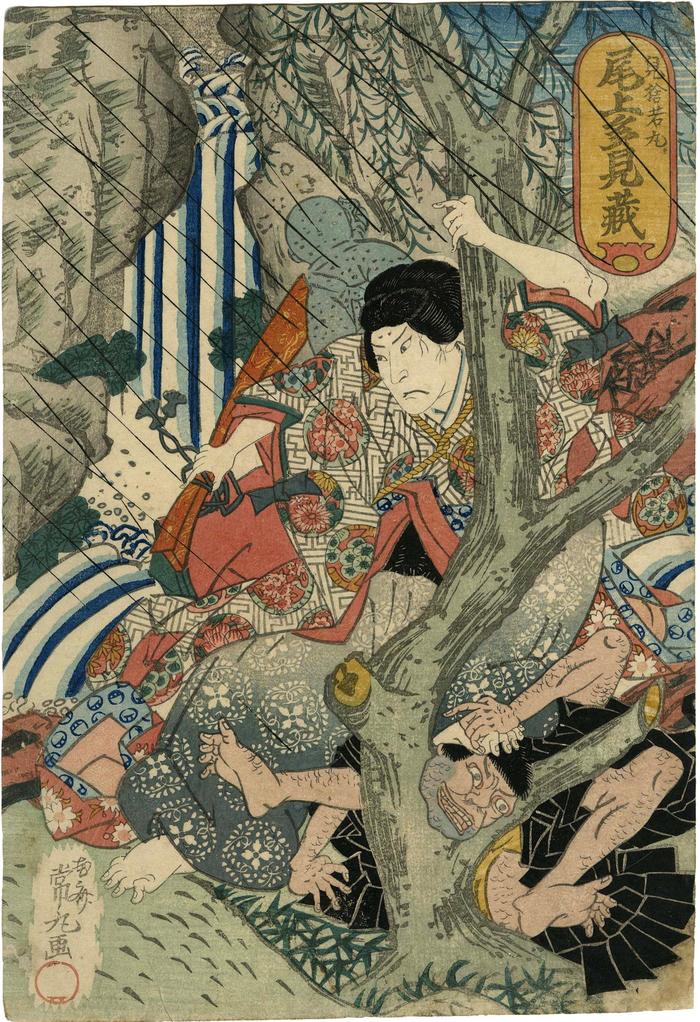Kasai Tsunemaru (花齋常丸) (artist )
Onoe Tamizō II as the chigo or young temple page Sutewakamaru (児捨若丸) from the play Keisei Chigo Ga Fuchi
01/1836
Japanese woodblock print
Signed: Kasai Tsunemaru ga (花齋常丸画)
Publisher: Unknown
Lyon Collection - Hokuei composition where Utaemon III plays Sutewakamaru The theatrical Sutewakamaru was the illegitimate son of Akechi Mitsuhide. He spent his childhood at a temple near the roiling waters of Chigo Ga Fuchi near Enoshima. Pursued by two older monks he decided to commit suicide by drowning himself in these waters, but was rescued by Mashiba Hisayorshi, the historical Toyotomi Hideyoshi, his sworn enemy and the killer of his father.
In the scene in this print Sutewakamaru has been attacked as he approaches the waters, but he is getting the better of his assailant. Immediately behind the young man we see the back of a stone statue of Jizō, who was the protective bodhisattva of the souls of little children.
In one of the many confounding elements of kabuki theater Sutewakamaru grows up to be Ishikawa Goemon, the central figure of many traditional plays.
****
This commemorates a performance at the Onishi Theater, Osaka in 1/1836.
"The Chigo Deep Water (Chigo ga fuchi) in the play title was located off the island of Enoshima. It was there in the twelfth century that a young acolyte or temple page (chigo) named Shiragikumaru committed suicide rather than choose between two priests who vied for his love. The play Keisei chigogafuchi (A courtesan and deep water at Chigo: けいせい稚児淵), along with Chigogafuchi koi no shiranami (Chigo deep water and the white waves of love: 児渕恋白浪), combined the legends of the outlaw Goemon with a revenge tale involving Shiragikumaru (renamed Sutewakamaru in the kabuki dramas). The conflated saga includes Sutewakamaru vowing to avenge the death of Takechi Mitsuhide who had been slain by Mashiba Hisayoshi (the theatrical namesake for the historical shôgun Toyotomi Hideyoshi). This links the Sutewakamaru plot with various Ishikawa Goemon mono ("plays about Ishikawa Goemon"), the legendary fugitive outlaw during the reign of Hideyoshi. Late in the play, Sutewakamaru transforms into Goemon.
In this scene Sutewakamaru appears to be holding an heirloom sword (wrapped in red cloth) while subduing a rather rough-looking, hirsuite adversary — the latter played by an unnamed walk-on actor. The action takes place by a waterfall with a hard slanting rain adding a dynamic touch to the intense portrayal."
Ex. collection Okada Isajiro (岡田伊三次郎).
This information is quoted directly from Osakaprint.com.
****
There is another print of this same figure in the Lyon Collection. That one is by Hokuei and in that one the character of Sukewakamaru is portrayed by Utaemon III. See the link above.
****
The historical Akechi Mitsuhide
Elena Varshavskaya wrote: "On the 2nd day of the 6th month of the 10th year of the Tenshō era (21 June 1582), the warlord Oda Nobunaga, who controlled about one third of Japan, was attacked by his vassal Akechi Mitsuhide at the Honnōji temple in Kyoto. Overwhelmed by the larger forces of the attackers, Oda Nobunaga met his fate amidst the burning ruins of the temple. Akechi was not the only one to turn against his master. In Japan in the 16th century, as regional lords fought for political supremacy over the entire nation, such acts of treachery were common occurrences. Akechi's assault was different because it resulted in many significant changes in the political landscape of Japan. Nobunaga's death opened the way for Toyotomi Hideyoshi, another of his vassals, to establish hegemony over Japan. Hideyoshi, a samurai of modest origin, was endowed with extraordinary talents both as a military commander and as a politician. On joining Oda Nobunaga's service, Hideyoshi quickly became his trusted vassal. By the time of Nobunaga' s sudden death, Hideyoshi was one of the most powerful warlords and influential political figures in Japan. The news of the fatal events in Kyoto reached Hideyoshi when he was fighting far away in the western part of the country. Understanding that an immediate victory over the 'traitor' would dramatically increase his chances of becoming Nobunaga's political heir, he hastened back to the capital. Eleven days after the Honnōji affair, Hideyoshi completely routed Akechi, who was killed by villagers as he fled the scene of the battle."
Note that the curatorial files at the British Museum state: "Mashiba Hisayoshi was the name used by kabuki theatrical convention for the character Hashiba Hideyoshi, that is, the military leader Toyotomi Hideyoshi (1536–98)." Takechi Mitsuhide is actually Akechi Mitsuhide.
****
Illustrated in Schätze der Kamigata: Japanische Farbholzschnitte aus Osaka 1780-1880, MNHA (Musée national d'histoire et d'art Luxembourg), 2012, p. 27, #29. The catalog entry reads in German: "Die Stück behandelt, ebenso wie seine Variante "Chigo Ga Fuchi Koi no Shiranami", die Jugenjahre des Sutewakamaru. Als illigetimer Sohn des Shoguns Takechi Mitsuhide wächt er in einem Templekloster in der Nähe des Chigo Strudels auf. Als er sich, mit einer Bodhisattva-Jizo-Statue beschwert, in dem Strudel ertränken will, er von Mashiba Hisayoshi (dem historischen Taiko Toyotomi Hideyoshi) gerettet, den zu töten er dem Geist seines Vaters Mitsuhide versprochen hatte."
"Später wird aus Sutewakamaru der Brigant Ishikawa Goemon, dessen Auseindersetzungen mit Hisayoshi Thema weiterer Theaterstücke sind Hier wird Sutewakamaru auf dem Weg zum oder von Strudel überfallen."
The Google translation is: "The play, like its variant "Chigo Ga Fuchi Koi no Shiranami", deals with the youth of Sutewakamaru. As the illegitimate son of the shogun Takechi Mitsuhide, he wakes up in a temple monastery near the Chigo whirlpool. As he is about to drown in the whirlpool, weighed down with a Bodhisattva Jizo statue, he is rescued by Mashiba Hisayoshi (the historical Taiko Toyotomi Hideyoshi), whom he had promised his father Mitsuhide's spirit to kill."
"Later, Sutewakamaru becomes the brigand Ishikawa Goemon, whose arguments with Hisayoshi are the subject of further plays. Here Sutewakamaru is attacked on the way to or from the whirlpool."
Onoe Tamizō II (二代目尾上多見蔵: 11/1820-1848; 1850-November, 1885) (actor)
actor prints (yakusha-e - 役者絵) (genre)
Kyōto-Osaka prints (kamigata-e - 上方絵) (genre)
